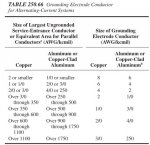Stevenfyeager
Senior Member
- Location
- United States, Indiana
- Occupation
- electrical contractor
Has anyone ever had a POCO require #4 to two ground rods for a 200 amp resi. service? I've had only one, but that makes me want to use #4 just in case. Thank you.


